Obidos, Portugal’s most picturesque town…
Surprise! The wide arch through which you enter the parking lot of Obidos turns out to be part of a 3-km long stone-mortar aqueduct. The rough queue of inverted U’s that make up the ancient structure seem to shorten in height as they stretch far into the distance, farther than your eye can see. You raise an eyebrow and purse your lips, impressed by the impeccable condition of the 16th-century marvel built to transport water to the town.
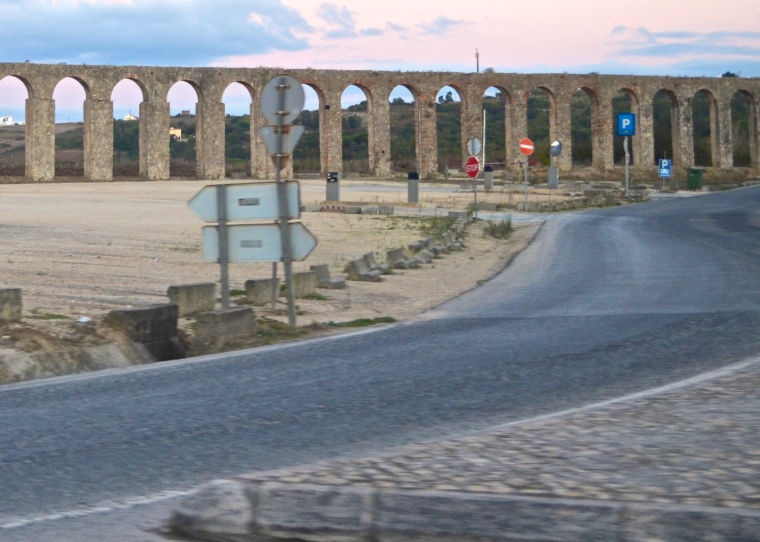
As you pan to the left, where the stone ramparts peek from behind thick foliage, this thought comes to mind. A fortified town with such a dramatic introduction would be anything but ordinary. Suddenly you’re a drone, soaring high, tracing the outline of the trapezoid-shaped fort enclosing a medieval town perched on a hill rising over endless plains. Can’t wait to lay your hands (oops, feet) on this oh-so-pretty Portuguese town trapped in the past, can you?

Nothing proclaims the authenticity of Obidos like its double-arched main entrance gate. The Porta da Vila flaunts the entire spectrum of vivid blues in its traditional azulejos tiles that depict the Passion of Christ. You can’t decide whether the colors enrapture you more or the delicacy of the patterns. And while you’re still oscillating with that decision, chew on the town’s illustrious legacy.
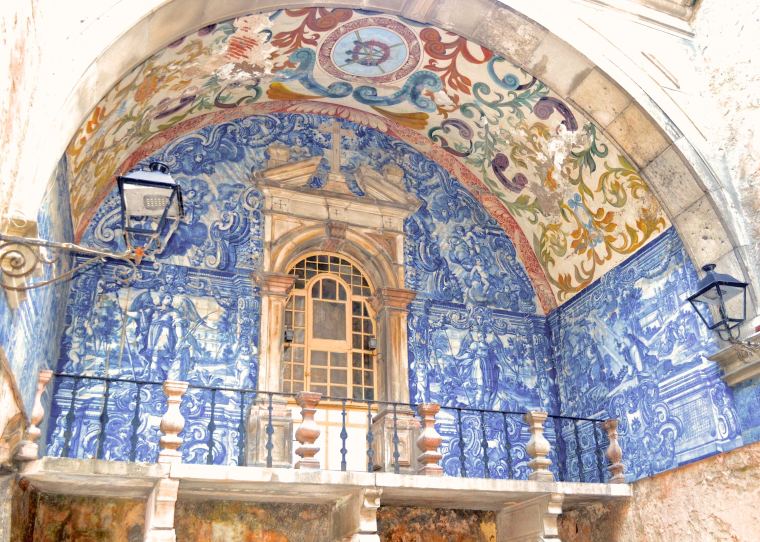
Obidos (Latin for citadel) changed hands from ancient Roman settlement to 5th-century Visigoth territory to 8th-century Moorish town before it finally became Portuguese land in the 12th-century. In the 13th-century, King Dinis gifted it to the object of his affection, Queen Isabel de Aragon and then onwards, the Queen’s Town has always been the property of Portugal queens. Some wedding gift, huh?
Straight into the ‘thick’ of things (if you can call it that) on the narrow main thoroughfare, Rua Direita. The uneven cobblestoned street is divided into two halves by a smooth walking strip right in the middle. Neat! Whitewashed houses lining either side sport vivid yellow and blue paint borders. Can’t go wrong with that colour combo. Terracotta planters suspending from iron rings adorn the sides of windows. Lush cascades of hot-pink bougainvillea drape corners of stone walls. And charming iron lamps add to the old-world charm. All the right elements.

Dainty cafe chairs facing the street still offer leg room, despite the moving crowd of passersby. Storekeepers stand in their doorways, inviting tourists with welcoming smiles. Pousadas advertise availability of homely rooms in multiple languages. Curious travellers poke into stores that announce ‘Artesenato Portugues’. Traditional local crafts like cork, handmade lace, brightly painted ceramic and wooden roosters liven up the shelves and windows all along the Rua Direita. Even if its a ‘tourist trap’, be the good guy, take the bait. Pick up a local souvenir, keep their craft alive, let them earn their livelihood.







Stop by at a store or a makeshift stall that sells the famous liqueur of the region, Ginjinha (Ginja). The finest Ginja in all of Portugal is produced right here…it would be a sin to give it a pass. Its either that, or the next best thing (for dessert-crazed humans of the world like me). Small chocolate cups of delight filled with Ginja. Devour the cup shamelessly. Allow the sweet, robust, cherry-flavoured brandy liqueur to slowly glide down your throat and you’re in palate paradise! Shopping cart full of Ginja bottles or Ginja chocolate bars or Ginja chocolate nuggets? Inevitable. Irresistible. Give in.


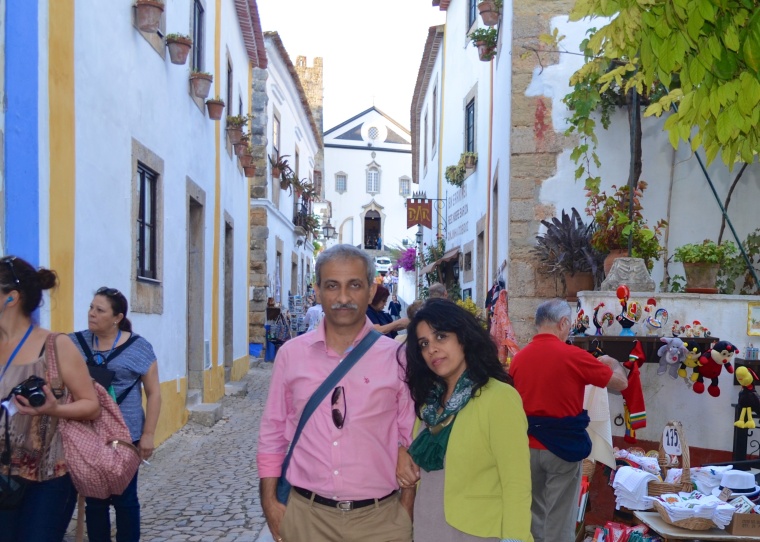
Coming to the story. The homemade Ginja tradition was born when the Romans planted Morello cherry (ginja) trees here, nuns started using cherries in desserts, and a friar made the liqueur concoction as we know it today. (Monk-and-beer saga of Munich come to mind?) Top tip for ginja seekers…Bar Ibn Errik Rex. This former antiques shop, where ginja was given free with every purchase, turned into a liqueur bar years back. One-in-a-million marketing gimmick gone right. Talk about freebie fishing in the fame!
Dig into the back alleys for the real treasures. Away from the cheerful shops and unwitting photo-bombers, deep into the labyrinth that criss-crosses the main street. Up and down the broad steps of the sloping stone streets. Where there’s not a soul in sight. Where the buzz of conversation slowly fades away, and the moving figures dissolve into emptiness. Where ladles stir in simmering pots on kitchens stoves. Where fresh herbs fill the gardens with fragrance. Where lace curtains adorn pretty windows and ivy creepers cling to blank white walls. Get drawn to the mellow light of the evening sun warming up the curves of a church dome, making a statement against the blue cloud- speckled sky. Study the fading, chipped bits of red brick tiles that drape over roofs like thick patchwork rugs. Run your eyes over the errant sprays of flowers that sprout from rooftops and ledges…free and unrestrained. Toss back your head and breathe in the freshness. Its all real.


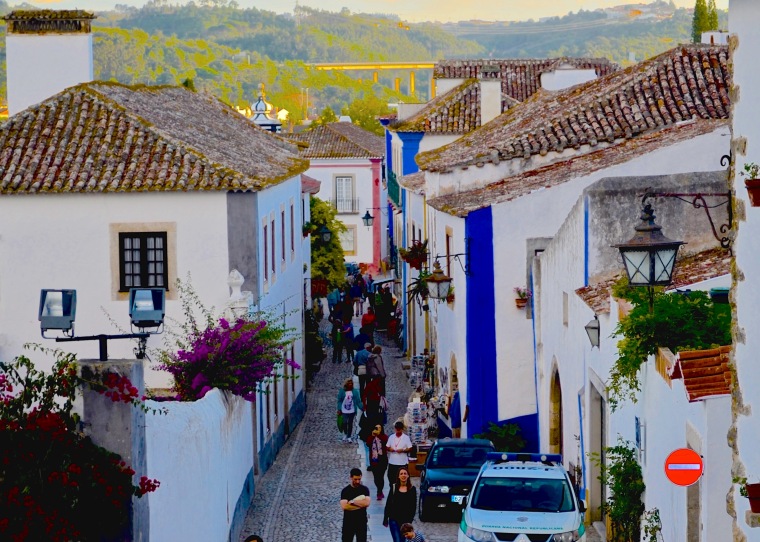


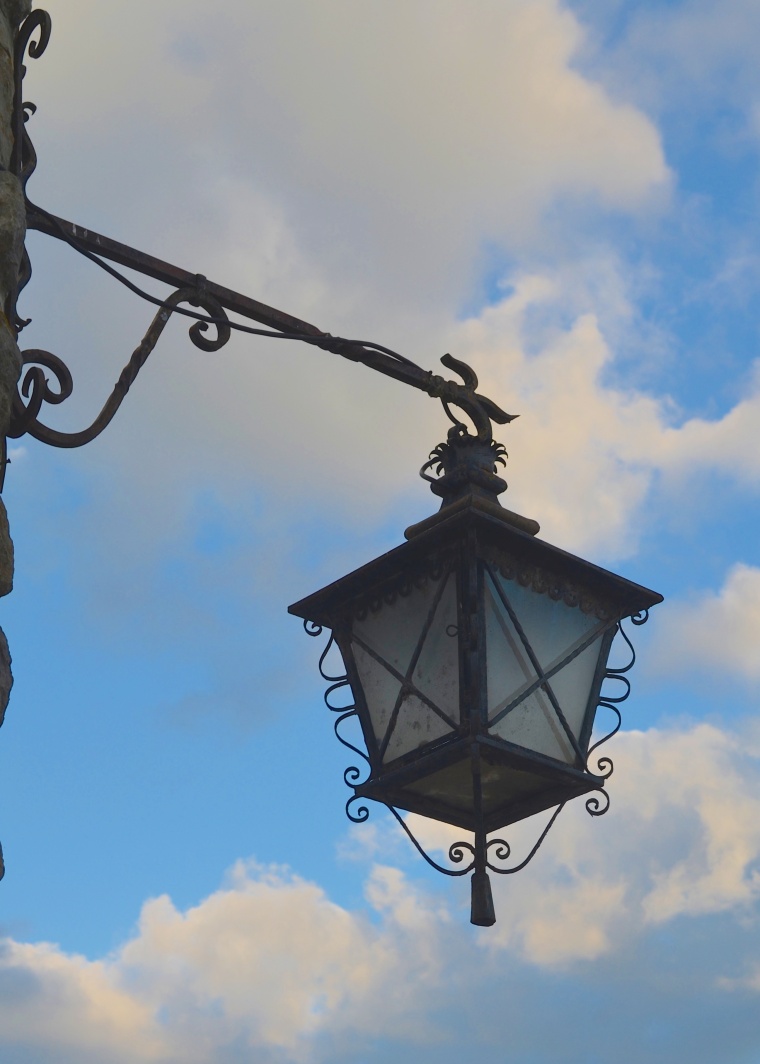

A little boy in a striped tee rolls a toys outside his blue-white home. An elderly lady walks to the local market to pick up fresh custard tarts. Do all the 3000 residents know each other by face or by name, you wonder. Do they come together like one big, happy family during the Medieval Fair in July-Aug? What a transformation…when the ancient streets are filled with festive flags and banners, locals in medieval costumes replaying the past, as if it were the present again. Ah, the fruits of relentless aimless wandering! Walk the 1.5 km long circuit of the walls for fabulous views of the town and the surrounding countryside. Not as dramatic as Dubrovnik or Lucca, but serenely stunning in its own way.
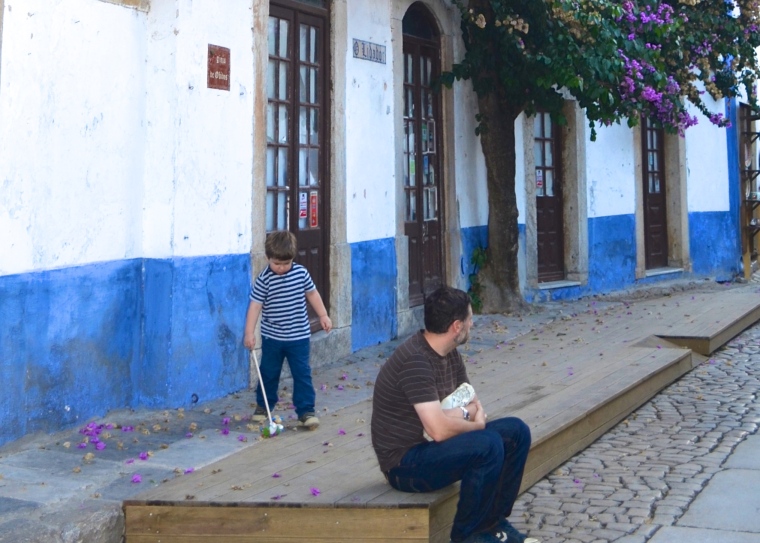


Where the main street ends, you land at a dead-end of sorts. Peek into the renaissance-style Igreja de Santiago, which now harbours an atmospheric bookstore. Catch glimpses of the Manueline-style castle that crowns the town in its reincarnation as a luxurious Pousada. And let your curiosity lead you through the giant arch in the Castle walls, just adjacent to the church, where a surprising spectacle await you. A small patch of garden beyond the castle wall, one roped-safety rail, shadows of thick trees, and infinite expanses of vineyards, stretching over the horizon! Time has frozen and you have turned invisible. Peace has a new name. But try to wrench yourself back into reality now. Because there’s not a soul in sight and you can be part of a live portrait, right here, right now. A portrait which will be the pride of your mantelpiece forever!






Pin this post for later!!




I love this! It really looks like travelling back in time an I would totally wanna buy one of the brightly painted ceramic things they sell. So pretty!
LikeLiked by 1 person
Going back in time is just the feeling one gets in Obidos. You must go if you get the chance.
LikeLike
Oh, I’ve heard such good things about Obidos!!! I was already dying to visit, and now, even more, thanks to your lovely photos of its winding streets.
LikeLiked by 1 person
I hope you have seen that last portrait. It will make you hop on to a flight ASAP.
LikeLike
There is no denying Odibos is incredibly photogenic. Every shot looks like it is from a postcard or a wine label. It would be so fun to see the medieval fair. One can only imagine how fantastic is was to immerse yourself in such deep history and their proud culture.
Thanks for sharing. Keep travel blogging. Adventure is better shared with friends!
LikeLiked by 1 person
Little towns like these fascinate me to no end and each time we visit these, I picture myself living there. Such a different world.
LikeLike
Obidos sounds and looks enchanting! Did you do a day-trip or did you stay overnight in the town? I can totally imagine myself strolling in the streets and overdosing on Ginja chocolates!! Thanks for sharing 🙂
LikeLiked by 1 person
We did a daytrip but stayed till sunset, so it was a dream 🙂 That portrait I have shared at the end is my fave picture of all times.
LikeLiked by 1 person
Obidos may have been one of my favourite small towns we visited in Portugal. We stayed inside the walls. So had to figure out how to drive in through those gates! A scary start. We definitely made sure to sample Ginja – maybe more than once. Did you walk around the walls? It so was magical at sunset. Thanks for taking me back.
LikeLiked by 1 person
It must have been very special staying in Obidos overnight and seeing the atmosphere change at different parts of the day. We did a day trip but stayed till sunset. That’s how we got that surreal portrait which I have shared at the end of the post.
LikeLike
Gosh, that has taken me back. I haven’t been to Obidos for nearly thirty years but I remember it vividly because we stayed in the Pousada, which is a castle built into those walls. What a beautiful place it is – so quintessentially Portuguese and charming
LikeLiked by 1 person
Thirty years later, you would probably find Obidos just the same. Minus the visitors on the streets, though. 🙂 Thanks so much for your lovely comment.!!
LikeLike
I can totally agree with the title…it truly is! In general I found Portugal such a photogenic place from north to south. The beach towns vs north are as beautiful but have lovely differences. The tile work and colors aren’t comparable to other European cities! Great read!
LikeLiked by 1 person
Thank you so much. I have a few more posts on Portugal, in case you’re interested. You can find them by searching gor keyword Pprtugal on my site
LikeLike
You make a persuasive case for Obidos being the most picturesque town in Portugal. Love the colorful buildings and the arch you posted in the beginning.
LikeLiked by 1 person
Thank you! I thought it was a delightful place. 🙂
LikeLike
Obidos looks so rich in history and a city I would most definitely like to explore. I love arched entrance gates and would love to see the azulejos tiles that depict the Passion of Christ. Your photo of it is so pretty! I like that you included what Obidos means because now that I know it means “citadel” in Latin, it helps shape the city for me in my mind and connects all the ramparts, etc. All the multi-color buildings are beautiful too!
LikeLiked by 1 person
I love finding the meaning of every place we visit. Sets the perspective right.
LikeLike
I am dreaming of chocolate cups of delight filled with Ginja 🙂 Obidos is so rich in history, I love walking through those streets. Wish I had included it in my Portugal itinerary.
LikeLiked by 1 person
Portugal would be great for you, since you a history buff, Indrani.
LikeLike
I love this town from your words and photos. White-washed houses? Check. Bougainvillaea? Check! Gorgeous tiles? Check! Cute cafes and decadent desserts? Check! Check! What more could I ask for!
LikeLiked by 1 person
🙂 🙂 🙂 Looks like we like the same kind of places!
LikeLike
I have never heard of this place. It looks amazing, so picturesque. Definitely a place to visit when in Portugal! 🙂
LikeLiked by 1 person
Yes, Portugal doesn’t receive all the attention it deserves.
LikeLiked by 1 person
👍🏼😊
LikeLiked by 1 person
Wonderfully photography. And may I just say, I love your husbands’ moustache!
LikeLiked by 1 person
Thank you and will convey to him 🙂
LikeLike
It does look gorgeous! I love exploring narrow cobble-stoned streets, so it’s definitely my cup of tea. Initially, I thought it’s kind of busy, but the second half of your photos proved that there are plenty of spots to escape the crowds.
LikeLiked by 1 person
Every busy town has a secret side waiting to be found 🙂
LikeLike
Obidas looks really amazing, I’d love to visit it one day for the views and sense of antiquity alone. I especially liked the idea of Ginga (I love cherry flavoured alcohol). Would love to see this place and soak up the culture.
LikeLiked by 1 person
It is quite adorable, isn’t it?
LikeLike
I so love small towns and I’m charmed by your photos of Obidas. I’d love to try Ginja and loved hearing the story about how the tradition started.
LikeLiked by 1 person
Thanks Lara. You must include Obidos in your Portugal trip, whenever you plan for it.
LikeLike
Obidos looks like a poem etched in stone, a place caught in a time warp. What a beautiful and charming place. The ancient aqueductblooks really impressive, these ancient engineering marvels never fail to amaze me. It would be such a pleasure to stroll in the town on those cobbled streets.
LikeLiked by 1 person
You have described Obidos just perfectly. Little towns like these…my fave!
LikeLike
I took my daughters to Portugal and travelled north to south. We stopped in Sinatra for a couple nights and were mesmerized by its beauty. Looks like we missed out on another gem of a town. Will need to return for another adventure! Beautiful photos.
LikeLiked by 1 person
Looks like your trip to Portugal was quite comprehensive. Do stop at Obidos if you happen to go to that part of the world again.
LikeLike